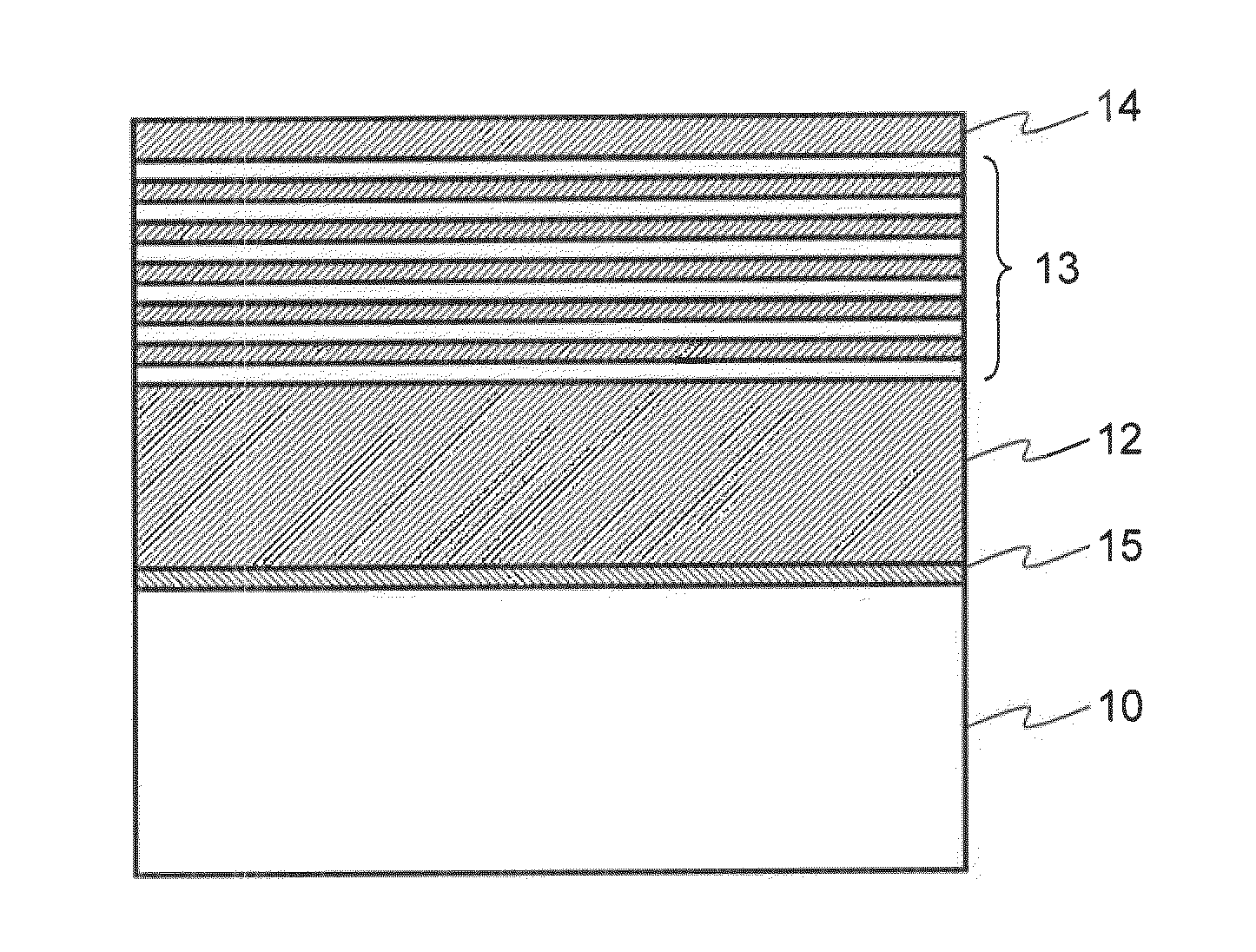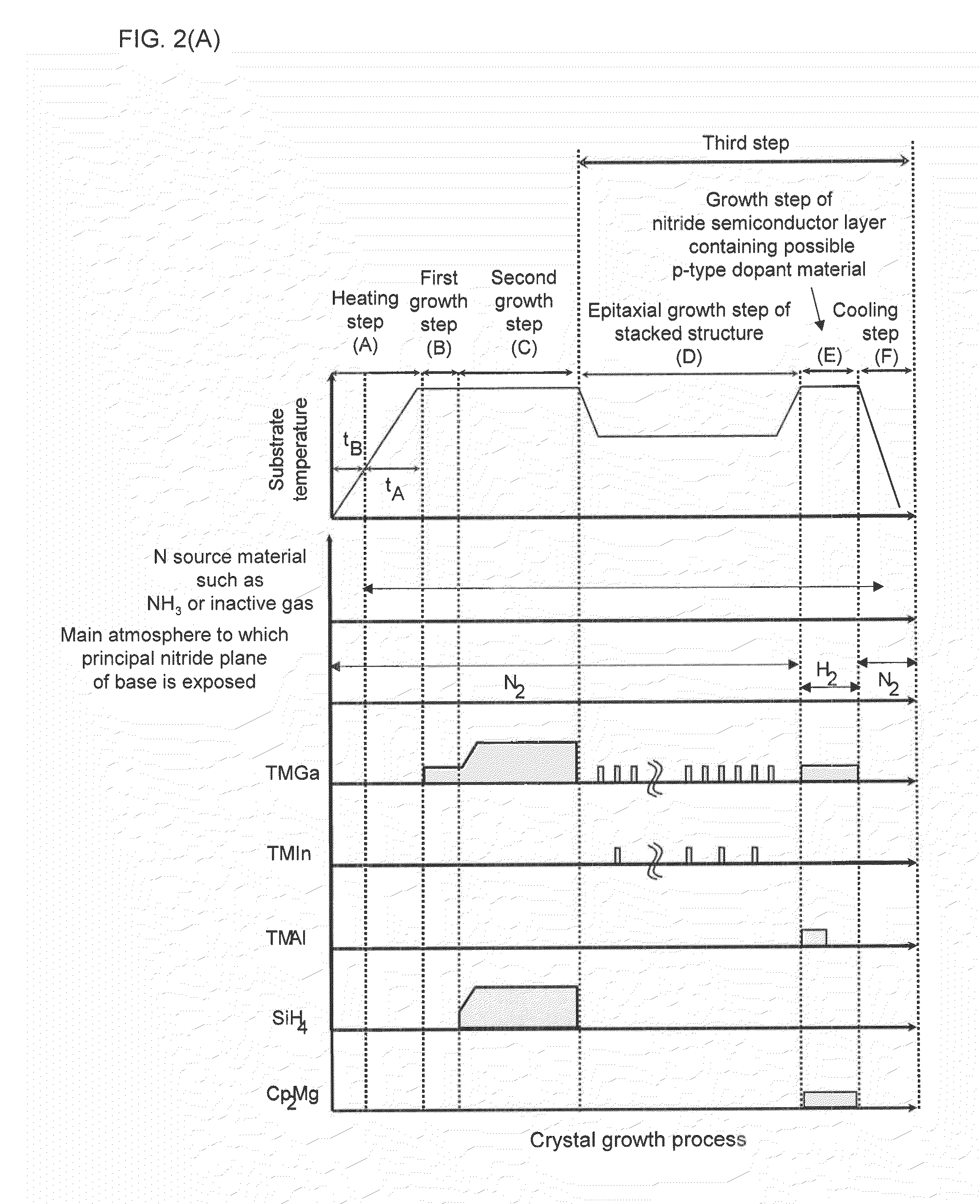Nitride semiconductor, nitride semiconductor crystal growth method, and nitride semiconductor light emitting element
a nitride semiconductor and crystal growth technology, applied in the direction of crystal growth process, polycrystalline material growth, chemically reactive gas, etc., can solve the problem of high dislocation density, insufficient dislocation density of ingan in blue-color light-emitting regions normally used as quantum well layers of gan-based leds, and unavoidable gan crystal epitaxial growth on sapphire substrates. , to achieve the effect of improving the crystallinity of the n
- Summary
- Abstract
- Description
- Claims
- Application Information
AI Technical Summary
Benefits of technology
Problems solved by technology
Method used
Image
Examples
example 1
[0226]In the present example, a stack of gallium nitride-based semiconductor thin films was grown by the MOCVD process and a near ultraviolet LED was fabricated. A series of crystal growth processes for that has already been outlined with reference to FIG. 2(A). Also, a layer structure after growth is schematically shown in FIG. 3(A).
[0227]The base used was a (1-100) m-plane oriented freestanding GaN substrate. The substrate measured 4.1 mm in the c-axis direction and 15 mm in the a-axis direction. Regarding electrical characteristics, the substrate was n-type and carrier density was 6.6×1017 cm−3. As a result of X-ray diffraction, the full-width at half maximum of a (10-12) reflection rocking curve was 34.2 arcsec., OFF angle in the c(+) direction was 0.25 degrees, and OFF angle in the A direction was 0.03 degrees. Also, the dislocation density was 5.0×106 cm−2.
[0228]The m-plane freestanding GaN substrate was placed on a tray (susceptor) in a horizontal quartz reactor which normall...
example 2
[0244]In the present example, a stack of gallium nitride-based semiconductor thin films was grown by the MOCVD process and a near ultraviolet LED was fabricated. A series of crystal growth processes for that has already been outlined with reference to FIG. 2(A). Also, a layer structure after growth is schematically shown in FIG. 3(A).
[0245]The base used was a (1-100) m-plane oriented freestanding GaN substrate. The substrate measured 4.2 mm in the c-axis direction and 15 mm in the a-axis direction. Regarding electrical characteristics, the substrate was n-type and carrier density was 6.7×1017 cm−3. As a result of X-ray diffraction, the full-width at half maximum of a (10-12) reflection rocking curve was 32.8 arcsec., OFF angle in the c(+) direction was 0.29 degrees, and OFF angle in the a direction was 0.05 degrees. Also, the dislocation density was 5.4×106 cm−2. The m-plane freestanding GaN substrate was placed on a tray (susceptor) in a horizontal quartz reactor which normally ope...
example 3
[0253]In the present example, a stack of gallium nitride-based semiconductor thin films was grown by the MOCVD process and a near ultraviolet LED was fabricated. A series of crystal growth processes for that has already been outlined with reference to FIG. 2(A). Also, a layer structure after growth is schematically shown in FIG. 3(A).
[0254]The base used was a (1-100) m-plane oriented freestanding GaN substrate. The substrate measured 4.0 mm in the c-axis direction and 15 mm in the a-axis direction. Regarding electrical characteristics, the substrate was n-type and carrier density was 6.4×1017 cm−3. As a result of X-ray diffraction, the full-width at half maximum of a (10-12) reflection rocking curve was 36.7 arcsec., OFF angle in the c(+) direction was 3.0 degrees, and OFF angle in the a direction was 0.3 degrees. Also, the dislocation density was 5.1×106 cm−2. The m-plane freestanding GaN substrate was placed on a tray (susceptor) in a horizontal quartz reactor which normally opera...
PUM
| Property | Measurement | Unit |
|---|---|---|
| area | aaaaa | aaaaa |
| surface roughness Ra | aaaaa | aaaaa |
| temperature | aaaaa | aaaaa |
Abstract
Description
Claims
Application Information
 Login to View More
Login to View More - R&D
- Intellectual Property
- Life Sciences
- Materials
- Tech Scout
- Unparalleled Data Quality
- Higher Quality Content
- 60% Fewer Hallucinations
Browse by: Latest US Patents, China's latest patents, Technical Efficacy Thesaurus, Application Domain, Technology Topic, Popular Technical Reports.
© 2025 PatSnap. All rights reserved.Legal|Privacy policy|Modern Slavery Act Transparency Statement|Sitemap|About US| Contact US: help@patsnap.com



